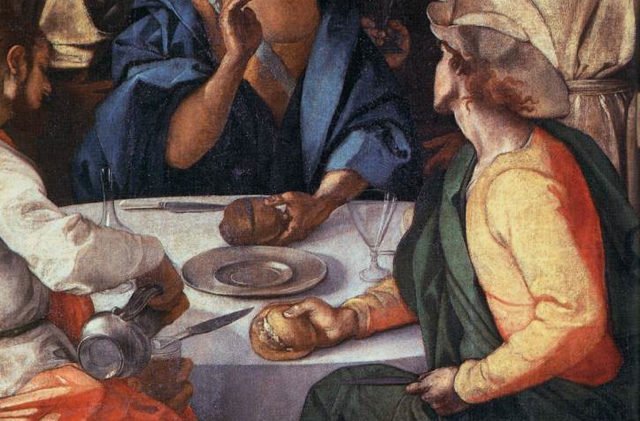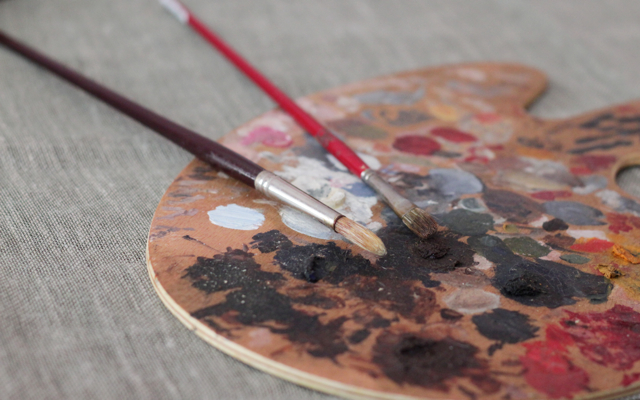The Artist’s Table
When you live in a city where the stones of nearly every building have witnessed the hand prints or the footsteps of famous artists and architects, you can either get used to it quickly and forget about it or continue to marvel at the history of the place with every step that you take when you pass through the city. I’m of the latter party; it was one of the things that first struck me on my very first visit to Florence as a sixteen year old, and is something that is still with me. Sometimes I find myself wondering, as I cut through the Palazzo Vecchio to avoid the crush of tourists between the Loggia dei Lanzi and the Uffizi Gallery, who else before me passed through this doorway or perhaps leaned on this column to fix his shoe like I’m doing now? Michelangelo maybe, or Da Vinci. Bronzino surely must have… then the questions keep coming as I turn into the piazza to slip in a quick coffee. I wonder what they would have eaten for breakfast? Or lunch or dinner for that matter.

Luckily one of my favourite artists of all time, Pontormo, an often misunderstood Mannerist artist, actually kept a sort of diary in the years just before his death, between 1554 and 1556, which was very much a food journal.
Art historians had put Pontormo down as an “obsessive” and “neurotic” person, which is a bit harsh really, considering that at this stage he was an older, tired man, busy with a number of impossible commissions asked of him by the Medici dukes. His notes, jotted down on scraps of paper together with little sketches, chronicle his progress on his last work, the frescoes in the San Lorenzo church (a work, by the way, that was destroyed in the 18th century), but mostly, they mention what he ate every day. The result is a humble account of a modest Renaissance diet.

Although Pontormo was also described as antisocial, he does note some of the fantastic dinners he enjoyed with his pupil and good friend, Bronzino. In one entry, he writes that after an over-indulgent Sunday lunch with Bronzino, which turned into supper (something that Florentines are still very good at), he fasted until Wednesday when he could finally bring himself to have “some Trebbiano and a couple of eggs.” (Slightly reminiscent of Elizabeth David: “Let’s just have an omelette and a glass of wine.”)

Elizabeth Pillod, whose research on the artist has recently caused many to rethink the 500 year old prejudice that he was just a psychologically disturbed and cranky old man, translated the following part of his diary, just to give you a “taste” of what the painter had on his plate:
On the 11th of March 1554, on Sunday morning, I ate lunch with Bronzino—chicken and veal—and felt well (it is true that I was in bed when he came for me at home. It was quite late and upon getting up I felt swollen and full. It was a very beautiful day). In the evening I ate a bit of roasted dry meat which made me thirsty.
Monday evening I ate a cabbage and an omelet.
Tuesday evening I ate one half of the head of a kid and soup.
Wednesday evening I had the other half, fried, and a pretty big helping of zibibbo grapes, and 5 quattrini of bread, and capers in salad.
Thursday evening, a soup of good mutton and salad of goat’s beard.
Friday evening, salad of goat’s beard and two eggs in an omelet.
Saturday, fasted. Sunday evening, which was the evening of Palm Sunday, I ate a little boiled mutton and salad, and had to eat three quattrini of bread.
Monday evening after dinner I felt very lively and agreeable. I ate a salad of lettuce, a thin soup of good mutton and 4 quattrini of bread.
Tuesday evening I ate a salad of lettuce and an omelet.
Holy Wednesday: evening, 2 quattrini of almonds, and an omelet and some walnuts. And I did the figure that is above the head [of another figure]. The Duchess came to San Lorenzo; the Duke came, too.
Thursday evening, a salad of lettuce and some caviar, and one egg.
Friday evening an omelet with fava beans, and a bit of caviar and 4 quattrini of bread. Saturday I ate two eggs.
Sunday, which was Easter morning and the Feast of the Annunciation, I went to eat lunch with Bronzino. And I ate dinner there, too.
Monday evening I ate a salad that was of borage and a half-lemon, and 2 eggs in an omelet.
Tuesday evening I was all hoarse and ate a rosemary bread and an omelet and a salad and some dry figs.
Wednesday, fasted.
Thursday evening, a rosemary bread, an omelet of one egg and a salad and 4 quattrini of bread, in all.
While Pontormo’s notes on his everyday diet is a modest and revealing account of the solitary life of an old but determined artist, a little earlier in 1512, twelve of Florence’s most famous artists and poets had formed a sort of Renaissance supper club. Known as La Compagnia del Paiuolo, members were to contribute creative, aesthetically pleasing dinners for each other, one more inventive than the next. The duplicating of ideas was strictly punished. Their motto in fact was l’arte si fa a cena – art is made at dinner. Sometimes this included the actual setting of the supper, not just the meal itself. For example, the architect and sculptor Gianfrancesco Rustici once invited his guests to eat in what seemed to be a giant, steaming trompe l’oeil tub (a reference to the paiuolo, of the club’s name, a large copper pot for cooking over a fire) where everyone’s dishes were held up on the boughs of a moving tree.
Meanwhile, the painter Andrea del Sarto once contributed a gastronomic version of Florence’s Baptistery, complete with columns made of sausages, a marble floor of soprassata, decorated with a choir book made of sheets of lasagne and a choir of roasted birds as singers.
This whimsical, creative cooking is hard to find in Florence these days, but I just can’t help thinking about it as I walk through the heart of the city to pick up a quick lunch. Maybe I’ll just have an omelette and a glass of wine.




Comments
really enjoyed the read emiko, i love this food blog!!!
thanks my dear 🙂
Best. Article. EVER!
So glad you liked it! For some reason I thought you might like the Renaissance slant to this post! 😉
Beautiful images of an old man and him scraping the essentials together to have a pretty healthy diet. I bet he was fighting fit with that much nourishment.
The obvious next step Emiko is you have to replicate his diet from the journal for yourself and make a movie about it. Doco of course or maybe romantic drama.
Great writing.
One egg omelette?
Thanks, you always have brilliant ideas. Will keep them in mind for sure! The omelette in the photo here was actually a two egg omelette but two very, very tiny eggs from my sister in laws’ little dainty hens – so yeah, one (normal) egg omelette!
Fantastic post. I quite like Pontorno, i only watched their pictures at the London National Gallery and their Jospeh paints, but i would like see more of him like the famous Visitation
So interesting! I adore Pontormo too and remember scouring this diary for clues to his art-making and coming up frustratingly short. I love your fresh food-focused approach to help me see him in a new light.
Fascinating posts pertaining to art history always turn up in the unlikeliest places – in this case a food blog! Fascinating stuff. Great work Emiko!
Kind Regards
H Niyazi
3pipe.net
Thanks so much! Isn’t it wonderful when different aspects of culture (whether it be food or art) intertwines? In Florence, not surprisingly, it’s not hard to come across good examples like this 🙂
Great post, Emiko! Complimenti! I knew the moment I saw the ‘Supper at Emmaus’ I knew I was in for something good.
Was Pontormo all that cranky? They say that only Bronzino could put up with his nasty character… but then, Bronzino and he had a very special relationship.
Thanks Eugene, I have always been a big fan of Pontormo so this post was just waiting to happen… I don’t think he got a very fair “vita” from Vasari – he was described as antisocial, neurotic, even bizzare – but I suppose it adds a bit of controversy and excitement instead of “he was actually a really lovely guy”! 😛